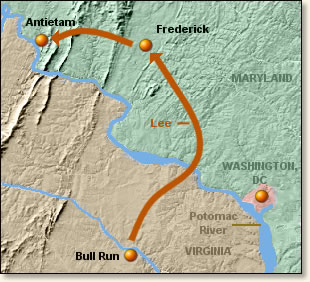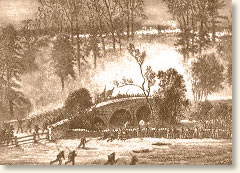|
Carnage At Antietam, 1862
General Robert E. Lee's first invasion of the North was a huge gamble that held the potential of very great rewards. Lee's campaign could win Maryland for the Confederacy, earn diplomatic recognition from Britain and France, and perhaps even force the Union to sue for peace. It would also take his troops out of war-ravaged Virginia during harvest time, and enable his troops to live off the enemy's country for a while. Following his victory at the Second Battle of Bull Run Lee led his ragtag army northward across the Potomac River and into Union territory.
The ensuing battle on September 17 produced the bloodiest day in American
combat history with over 23,000 casualties on both sides. More than twice as
 many Americans were killed or mortally wounded in combat at Antietam that day
as in the War of 1812, the Mexican War, and the Spanish-American War combined. many Americans were killed or mortally wounded in combat at Antietam that day
as in the War of 1812, the Mexican War, and the Spanish-American War combined.
The two armies met in the Maryland farm fields bordering the trickling Antietam Creek near the town of Sharpsburg. The Union named the conflict the Battle of Antietam in honor of the creek while the South called it the Battle of Sharpsburg in honor of the town. From dawn till dark on the 17th the two armies threw frontal attacks at each other, littering the fields with their dead and wounded. "The whole landscape for an instant turned red," one northern soldier later wrote. Another veteran recalled, "[The cornfield] was so full of bodies that a man could have walked through it without stepping on the ground." No clear victor emerged and the fighting stopped out of shear exhaustion. Lee withdrew during the night of September 18, and re-crossed the Potomac. Tactically, the battle ended in a draw. Strategically, it was a victory for the Union.
Some of the day's most brutal combat occurred during the late morning along a sunken road held by the Confederates. For two and one half hours Union troops threw themselves at the entrenched Confederates finally dislodging them. The murderous fire from both sides left the battlefield strewn with corpses giving the road the name "Bloody Lane." Lt. Frederick Hitchcock was a member of the 132d Pennsylvania Volunteers and experienced his first combat that day.
"We...moved, as I thought, rather leisurely for upwards of two miles, crossing
Antietam Creek, which our men waded nearly waist deep, emerging, of course,
soaked through, our first experience of this kind. It was a hot morning and,
therefore, the only ill effect of this wading was the discomfort to the men
of marching with soaked feet. It was now quite event that a great battle was
in progress. A deafening pandemonium of cannonading, with shrieking and bursting
shells, filled the air beyond us, towards which we were marching. An occasional
shell whizzed by or over, reminding us that we were rapidly approaching the
'debatable ground.'
"Soon we began
to hear a most
ominus sound."
|
Soon we began to hear a most ominous sound which we had never before heard, except
in the far distance at South Mountain, namely, the rattle of musketry. It had
none of the deafening bluster of the cannonading so terrifying to new troops,
but to those who had once experienced its effects, it was infinitely more to
be dreaded. These volleys of musketry we were approaching sounded in the distance
like the rapid pouring of shot upon a tinpan, or the tearing of heavy canvas,
with slight pauses interspersed with single shots, or desultory shooting.
All this presaged fearful work in store for us, with
what results to each personally in the future, measured probably by moments,
would reveal. How does one feel under such conditions? To tell the truth,
I realized the situation most keenly and felt very uncomfortable. Lest there
might be some undue manifestation of this feeling on my conduct, I said to
myself, this is the duty I undertook to perform for my country, and now I'll
do it, and leave the results with God. My greater fear was not that I might
be killed, but that I might be grievously wounded and left a victim suffering
on the field. The nervous strain was plainly visible upon all of us. All
moved doggedly forward in obedience to orders, in absolute silence so far
as talking was concerned. The compressed lip and set teeth showed that nerve
and resolution had been summoned to the discharge of duty. A few temporarily
fell out, unable to endure the nervous strain."
On the night of September 16, the 9th N.Y. Volunteers took up their position opposite a stone bridge crossing Antietam Creek and awaited orders. As dawn broke, the soldiers could hear the sounds of battle on their right and left but no orders were given to advance. By afternoon, as the fighting ebbed and flowed on other parts of the battlefield, General Burnside gave the order for his troops to attack the Confederates positioned across the Antietam Creek. David Thompson, a member of the 9th N.Y. volunteers describes his experience:
"So the morning wore away and the fighting on the right ceased entirely.
That was fresh anxiety -- the scales were turning perhaps, but which way? About
noon the battle began afresh. This must have been Franklin's men of the Sixth
Corps, for the firing was nearer, and they came up behind the center. Suddenly
a stir beginning far upon the right, and running like a wave along the line,
brought the regiment to its feet. A silence fell on every one at once, for
each felt that the momentous 'now' had come. Just as we started I saw, with
a little shock, a line-officer take out his watch to note the hour, as though
the affair beyond the creek were a business appointment which he was going
to keep.
When we reached the brow of the hill the fringe of trees along the creek screened
the fighting entire, and we were deployed as skirmishers under their cover.
We sat there two hours. All that time the rest of corps had been moving over
the stone bridge and going into position on the other side of the creek. Then
were ordered over a ford which had been found below the bridge, where the water
was waist deep. One man was shot in mid-stream.
At the foot of the slope on the opposite side the line was formed and we moved
up through the thin woods. Reaching the level we lay down behind a battery
which seemed to have been disabled. There, if anywhere, I should have remembered
that I was soaking wet from my waist down. So great was the excitement, however,
that I have never been able to recall it. Here some of the men, going to the
rear for water, discovered in the ashes of some hay-ricks which had been fired
by our shells the charred remains of several Confederates. After long waiting
it became noised along the line that we were to take a battery that was at
work several yards ahead on the top of a hill. This narrowed the field and
brought us to consider the work before us more attentively.
Right across our front, two hundred feet or so away, ran a country road bordered
on each side by a snake fence. Beyond this road stretched a plowed field several
hundred feet in length, sloping up to the battery which was hidden in a corn
field. A stone fence, breast-high, inclosed the field on the left, and behind
it lay a regiment of Confederates, who would be directly on our flank if we
should attempt the slope. The prospect was far from encouraging, but the order
came to get ready for the attempt.
 |
The charge at Antietam Bridge
from a contemporary illustration
|
Our knapsacks were left on the ground behind us. At the word a rush was made
for the fences. The line was so disordered by the time the second fence was passed
that we hurried forward to a shallow undulation a few feet ahead, and lay down
among the furrows to re-form, doing so by crawling up into line. A hundred feet
or so ahead was a similar undulation to which we ran for a second shelter. The
battery, which at first had not seemed to notice us, now, apprised of its danger,
opened fire upon us. We were getting ready now for the charge proper, but were
still lying on our faces. Lieutenant-Colonel Kimball was ramping up and down
the line. The discreet regiment behind the fence was silent. Now and then a bullet
from them cut the air over our head, but generally they were reserving their
fire for that better show which they knew they would get in a few minutes. The
battery, however, whose shots at first went over our heads, had depressed its
guns so as to shave the surface of the ground. Its fire was beginning to tell.
"He was cursing
a dying man."
|
I remember looking behind and seeing an officer riding diagonally across the
field - - a most inviting target - - instinctively bending his head down over
his horse's neck, as though he were riding through driving rain. While my eye
was on him I saw, between me and him a rolled overcoat with its traps on bound
into the air and fall among the furrows. One of the enemy's grape-shot had plowed
a groove in the skull of a young fellow and had cut his overcoat from his shoulders.
He never stirred from his position, but lay there face downward, a dreadful spectacle.
A moment after, I heard a man cursing a comrade for lying on him heavily. He
was cursing a dying man.
As the range grew better, the firing became more rapid, the situation desperate
and exasperating to the last degree. Human ature was on the race, and there
burst forth form it the most vehement, terrible swearing I have ever heard.
Certainly the joy of conflict was not ours that day. The suspense was only
for a moment, however, for the order to charge came just after. Whether the
regiment was thrown into disorder or not, I never knew. I only remember that
as we rose, and started all the fire that had been held back so long was loosed.
In a second the air was full of the hiss of bullets and the hurtle of grape-shot.
The mental strain was so great that I saw at the moment he singular effect
mentioned, I think, in the life of Goethe on a similar occasion - - the whole
landscape for an instant turned slight red.
I see again, as I saw it then in a flash, a man just in front of me drop his
musket and throw up his hands, stung into vigorous swearing by a bullet behind
the ear. Many men fell going up the hill, bit it seemed to be all over in a
moment, and I found myself passing a hollow where a dozen wounded men lay -
- among them our sergeant-major who was calling me to come down. He had caught
sight of the blanket rolled across my back, and called me to unroll it and
help to carry from the field one of our wounded lieutenants."
References:
David Thompson's and Frederick Hitchcock's accounts appear
respectively in: Buel,
Clarence, and Robert U. Johnson, ed., Battles and Leaders of the Civil War (1888;
reprint ed., 1982) Hitchcock, Frederick, War from the Inside (1904).
Additional sources: McPherson,
James M., Ordeal by Fire: The Civil War and Reconstruction (1982), McPherson,
James M., Battle Cry of Freedom: The Civil War Era (1988).
How To Cite This Article:
"Carnage At Antietam, 1862," EyeWitness to History, www.eyewitnesstohistory.com (1997).
|






